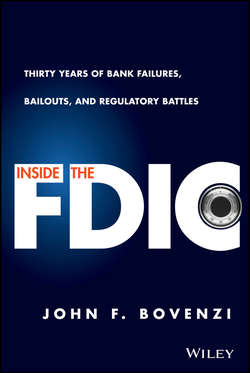Читать книгу Inside the FDIC - Bovenzi John F. - Страница 5
На сайте Литреса книга снята с продажи.
Introduction
ОглавлениеWe have heard little from the behind-the-scenes people who were on the front lines as the events of 2008 unfolded. Their actions can calm the storm and bring fair treatment to inherently unfair situations, or they can compound the problems. These often-maligned bureaucrats can either display courage, integrity, and fair play or contribute to an environment of fear, anger, and chaos.
This book doesn't focus on the arcane and mind-numbing details of capital, liquidity, and the other technical parts of a bank regulator's job. Instead, it puts human faces on the causes and effects of financial crises. These are personal stories of real people grappling with complicated issues while under enormous pressure, of individuals trying to ensure that they and others are treated fairly by our government, and of individuals misusing the system to serve their personal interests.
I spent 28 years as a bank regulator at the Federal Deposit Insurance Corporation (FDIC). During my career, I worked directly with ten FDIC chairmen and with many other senior government officials.
I was the highest-level FDIC career executive during the two biggest financial crises in the United States since the Great Depression. During the banking and S&L crisis of the 1980s and early 1990s, I assisted with the creation of the Resolution Trust Corporation (RTC) and personally had to explain to President George H. W. Bush that the FDIC's deposit insurance fund was running out of money. During the 2008 financial crisis, I helped develop the agency's policy and operational initiatives and served as chief executive officer at IndyMac Federal Savings Bank, the first large bank in over 20 years to be shut down and then reopened under government ownership.
Thus, I come to the topic with a perspective that's often absent from the financial-sector debates that play out on the airwaves and in the opinion pages. This book provides a different view of the FDIC and other bank regulators. Readers will see:
● How an agency that had become almost invisible would emerge as a major and highly independent force impacting U.S. financial markets.
● How 10 FDIC chairmen helped shape the FDIC and the U.S. financial regulatory system.
● How conflicts between the FDIC and other financial regulatory agencies unfolded amid the pressures and challenges associated with bank failures and financial crises.
I hope this book engages a different kind of discussion about the longer-term strategies needed to prevent repeating cycles of booms, busts, and bailouts. I also hope to encourage others to write about their experiences, so the historical perspective of long-term government employees can be added to policy debates in other regulatory arenas as well.
